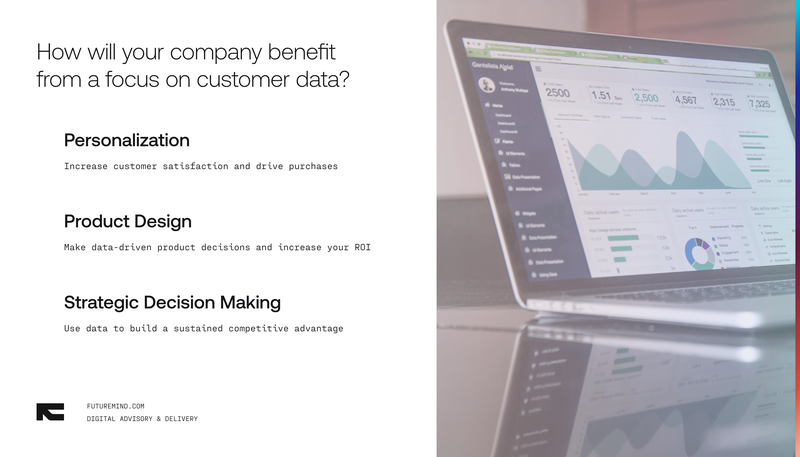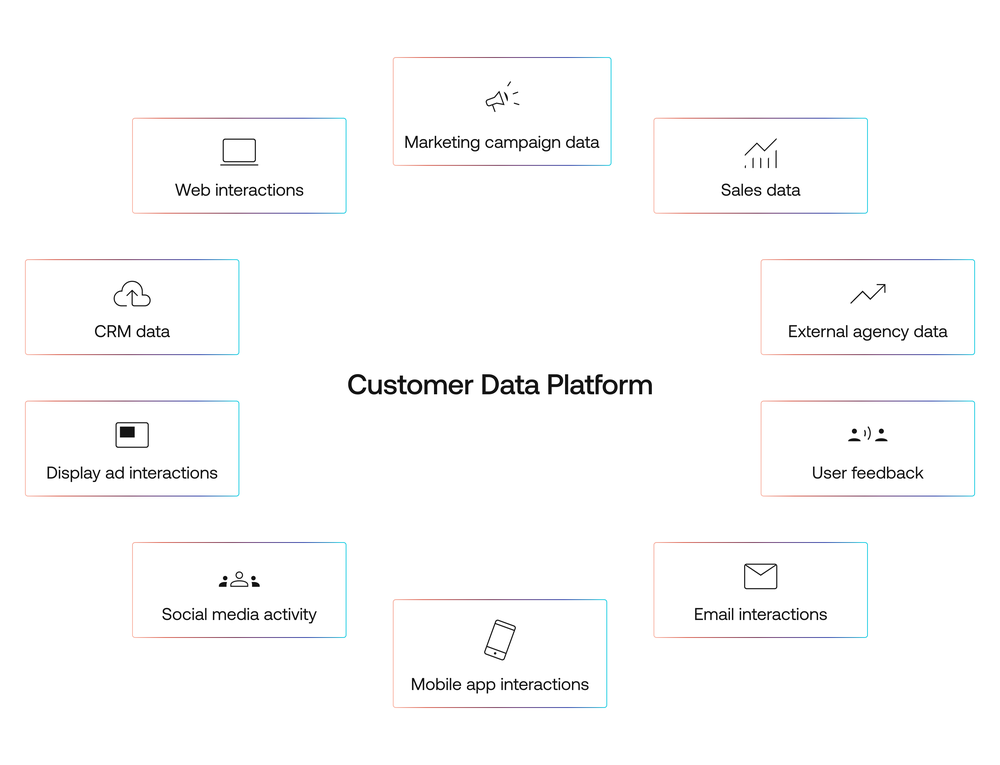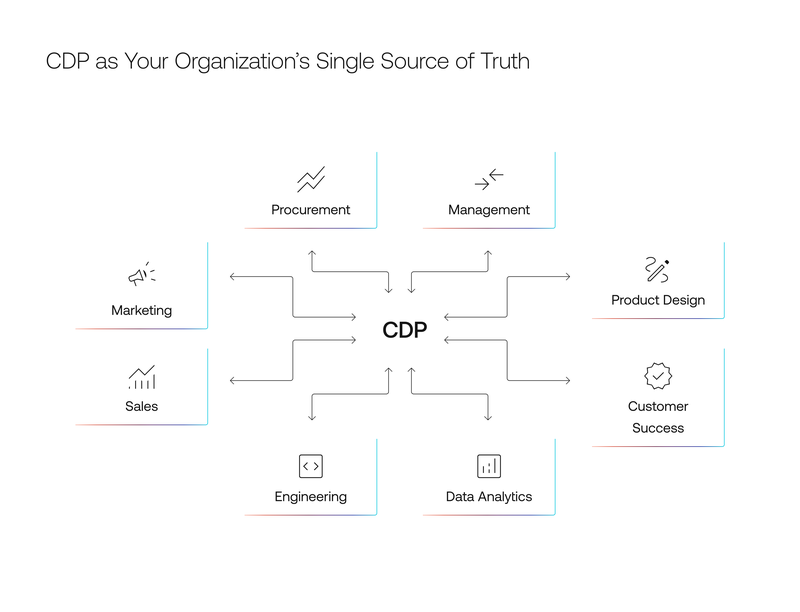
As the competition tightens in most sectors, businesses find themselves struggling with ever-increasing customer demands. What technological solution can your organization leverage to meet them? Our experience suggests choosing a customer data platform (commonly abbreviated as CDP). Read on to find out how implementing a customer data platform can help you increase revenue by loyalizing users and increasing their lifetime value.
In many cases, consumers don’t actually know what they need from you or why they do what they do. We’re not trying to imply anything negative about other people’s decision-making skills here. All of us make countless small choices that we could never explain because they are subconscious or rooted in biases, customs, and mental shortcuts.
Only a true understanding of customer needs and preferences will allow you to build great digital products and reap the associated rewards, though. So who do you ask for those coveted insights? You might be tempted to say “customers themselves”, but – while interacting with users is also of critical importance – it is not nearly enough.

Understanding mental shortcuts can make or break your product’s conversion rates, and the only way to take the right product design decisions in this confusing environment is by looking for actionable data insights. Before we tell you more about customer data platforms, let’s explore specific ways in which a strong focus on customer data will benefit your company.
Generic offerings have been a thing of the past for quite some time, and the sooner you stop seeing them as a viable option, the better for your business prospects. According to McKinsey’s Next in Personalization 2021 Report , 71% of consumers now expect companies to deliver personalized experiences. 76% report feeling frustrated when only a generic offer is available. The conclusion is obvious ‒ ignoring this ever-growing personalization trend means not just going against the grain, but also alienating around three-quarters of the average target group.
But let’s say you’re a numbers person without much regard for claims rooted in imprecise phenomena such as “feelings”. What about the money? Well, our money is still on personalization. Consumer preferences translate nearly 1:1 in just the type of decisions that drive revenue. Personalize, and you can expect your customers to be 76% more likely to purchase, 78% more likely to repurchase, and 78% more likely to recommend your products to friends and family. A very positive snowball effect waiting to happen ‒ at your company or at your competitor’s.
Companies that prioritize personalization grow their revenue on average 40% faster than their counterparts who do not. A strong focus on customers’ lifetime value means that this effect is likely to hold up in the long term. Personalization is not a fad ‒ rather, an investment in generating and sustaining a competitive advantage.
Consumers love personalized offers, but let’s go up a level. All those products, discounts, and recommendations are presented within your digital product ‒ a piece of software that is constantly evolving as your business specialists try to come up with new revenue streams and optimize the existing ones, and your engineers work to implement their ideas.
A new feature? Or maybe some subtle UI improvements? An information architecture redesign? All these sound like a great way to make your app or website bigger, better, faster, stronger… or, more realistically, better at meeting your KPIs and driving revenue growth. But which method should you opt for? What changes to make? And why? If you’ve read this far, you already know that the answer lies in properly storing and analyzing customer data .
According to a study by McKinsey , the companies who place in the top quartile for good ‒ data-driven ‒ design practices experience nearly double the revenue growth in comparison to the three lowest quartiles and boast a total return to shareholders higher by around 33%. McKinsey’s advice on how to achieve this sort of result? “ Fuse data and design to supercharge innovation ”. Sounds nice, performs even better.
We’ve had a look at specific offers, features, and products, but there is one more level to explore. What enables quality digital products and services to come to life, gain market share, and generate revenue is the organization composed of decision-makers like yourself. For the benefits of a data-driven approach to spread across the whole company, it has to be adopted at the highest level and taken into account when making strategic decisions. Otherwise, in the long term, instead of sustained growth you may encounter confusion and chaos.
According to an analysis by QuantumBlack , an AI-focused analytics company, by 2025, being “data-driven” will equal to data being “embedded in every decision, interaction, and process” . Information will be collected, processed, and analyzed in real time so that it’s always ready to use both for key decision makers and specialists. As the usage of data collection and management software becomes more widespread, and the possibilities of such software continue to develop in the meanwhile, QuantumBlack’s prognosis seems more and more likely. If you want to compete with the best in a few years, you need to start preparing for this increasingly data-driven world now – by the time the competition had made the switch, it might be too late.
Being aware that data is most likely where the answers to many of your questions are hidden is a great first step, but many companies don’t go much further than that. They try to collect and analyze data… But without the right knowledge and proper tools, it often proves too difficult to deliver results despite the best of intentions.

What are the most typical problems that businesses encounter when they fail to complete their due diligence in data management?
Worried that your company may be suffering from some of those issues – or maybe even them all? No shame in realizing that some things may need improvement. Indeed, that is the first step towards joining the world of data-driven business. The next step is a thorough data audit that will give you a proper understanding of your organization’s situation and actionable steps you can take to improve it both in the short and long term.
Throughout the article, we would often refer to “proper tools” – and a type of software that you might want to consider is a customer data platform. As usual, there are multiple competing options you can choose from, but what they have in common is a set of features that will allow you to deal with most typical problems associated with customer data management.

In particular – while it may not be sufficient to solve all your data-related issues – a customer data platform will hypercharge your personalization capabilities in marketing campaigns and customer experience thanks to data processing and predictive analytics.
As the information on user behavior is collected across the touch points of your product or service, a CDP will handle necessary processes such as matching, standardization, and validation, all that to ensure the history from all devices and channels is unified into a single customer view, in a format shared across the whole organization and accessible by all departments
This will make it much easier to personalize your offering and suggest the most appropriate products, discounts, and recommendations. However, a single customer view translates into more than just gaining an understanding of every consumer as an individual. It also unlocks the many possibilities of segmentation – dividing your users into groups that share common needs, behaviors, and interests, and are likely to react in similar ways to marketing campaigns and other loyalization efforts.
As specialized pieces of software delivered by verified vendors, all customer data platforms that we mention in this article are also known for a serious approach to security. They are fully GDPR-compliant and based on first-party data – the sort you collect directly from your customers over the course of your interactions rather than purchase from third-party providers.
What kinds of business issues can a customer data platform help address? Here are some examples:
As you can see, many possible CDP applications are directly or indirectly aimed at increasing long-term revenue, making it into a potentially high-ROI software investment.
Does a customer data platform sound like something that could improve your business outcomes? Your answer will quite likely be a “yes”, but now a new question arises: how to choose a customer data platform? There are several issues that you should consider before tying yourself to a CDP vendor:
Choosing a customer data platform is not an easy task and multiple stakeholders will likely need to be involved in the decision. Also, the optimal choice will likely depend on the characteristics of your organization. So where to start, given the abundance of solutions available on the market?
Based on our Solutions department’s experience in aiding our Clients, Zeotap is a quality customer data platform that scores very high on all the crucial criteria that we just mentioned. You can expect it to “collect, unify, segment, and activate” your data and support your business in multiple use cases aimed at increasing conversions, reducing costs, and building properly targeted marketing campaigns.
Zeotap handles identity resolution with a proprietary cross-platform ID+ solution that is compliant with European data privacy protection standards. It is also equipped with a robust set of integrations for both sourcing and making use of customer information. The Amplitude CDP may be another solution worth considering as the only platform of its kind that is natively integrated with analytics that help discover new audiences and sync behavioral data.
We know full well that selecting the right customer data platform is a high-stakes decision that requires a detailed understanding of your organization’s unique position in the market. Taking advantage of innovation experts’ knowledge can help minimize risk as you make this important choice for your company.
Implementing a CDP is a major organizational effort that requires a dedicated team, budget, and plenty of time. Thus, while the benefits of data standardization are obvious, its effects are usually visible after years rather than months. This fact is often either ignored or blocks the decision to implement a CDP in an organization. There are several simpler steps along the way, though, that can progressively bring you closer to gaining a 360-degree customer view. At Solutions, we know how to design the stages of CDP implementation in a way that will produce business results in just a few months.